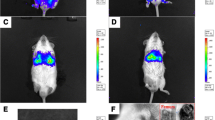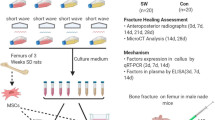Abstract
Human mesenchymal stem cells (hMSCs) have generated a great deal of interest in clinical application due to their ability to undergo multi-lineage differentiation. Recently, ex vivo genetic modification of hMSCs was attempted to increase their differentiation potential. The present study was conducted to evaluate the biodistribution and in vivo efficacy of genetically modified hMSCs. To accomplish this, Runx2, which is a key transcription factor associated with osteoblast differentiation, was transduced into hMSCs using lentiviral vectors expressing green fluorescent protein (GFP) or luciferase. Here, we developed an experimental fracture in mice femur to investigate the effects of Runx2-transduced hMSCs on bone healing and migration into injury site. We conducted bio-luminescence imaging (BLI) using luciferase-tagged vector and quantitative real-time PCR using GFP probe to investigate the biodistribution of Runx2-transduced hMSCs in the fracture model. The biodistribution of hMSC cells in the fractured femur was observed at 14 days post-transplantation upon both BLI imaging and real-time PCR. Moreover, the fractured mice transplanted with Runx2-transduced hMSCs showed superior bone healing when compared to mock-transduced hMSC and MRC5 fibroblasts which were used as control. These data suggested that transplanted genetically modified hMSCs systemically migrate to the fractured femur, where they contribute to bone formation in vivo.





Similar content being viewed by others
References
Barry, F.P., and J.M. Murphy. 2004. Mesenchymal stem cells: Clinical applications and biological characterization. International Journal of Biochemistry & Cell Biology 36: 568–584.
Bostrom, M.P., K.J. Saleh, and T.A. Einhorn. 1999. Osteoinductive growth factors in preclinical fracture and long bone defects models. Orthopedic Clinics of North America 30: 647–658.
Brighton, C.T., and R.M. Hunt. 1986. Histochemical localization of calcium in the fracture callus with potassium pyroantimonate: Possible role of chondrocyte mitochondrial calcium in callus calcification. Journal of Bone and Joint Surgery 68(5): 703–715.
Brighton, C.T., and R.M. Hunt. 1997. Early histologic and ultrastructural changes in microvessels of periosteal callus. Journal of Orthopaedic Trauma 11(4): 244–253.
Bucholz, R.W. 2002. Nonallograft osteoconductive bone graft substitutes. Clinical Orthopaedics and Related Research 395: 44–52.
Byers, B.A., G.K. Pavlath, T.J. Murphy, G. Karsenty, and A.J. Garcia. 2002. Cell-type dependent up-regulation of in vitro mineralization after overexpression of the osteoblast-specific transcription factor Runx2/Cbfal. Journal of Bone and Mineral Research 17: 1931–1944.
Chang, J.T., I.H. Chen, C.T. Liao, H.M. Wang, Y.M. Hsu, K.F. Hung, C.J. Lin, L.L. Hsieh, and A.J. Cheng. 2002. A reverse transcription comparative real-time PCR method for quantitative detection of angiogenic growth factors in head and neck cancer patients. Clinical Biochemistry 35(8): 591–596.
Choi, S.T., J.H. Kim, E.J. Kang, S.W. Lee, M.C. Park, Y.B. Park, and S.K. Lee. 2008. Osteopontin might be involved in bone remodelling rather than in inflammation in ankylosing spondylitis. Rheumatology (Oxford) 47: 1775–1779.
Chua, C.W., Y.T. Chiu, H.F. Yuen, K.-W. Chan, K. Man, X. Wang, M.-T. Ling, and Y.-C. Wong. 2009. Suppression of androgen-independent prostate cancer cell aggressiveness by FTY720: Validating Runx2 as a potential antimetastatic drug screening platform. Clinical Cancer Research 15: 4322–4335.
Dalle Carbonare, L., A. Frigo, G. Francia, M.V. Davì, L. Donatelli, C. Stranieri, P. Brazzarola, M.C. Zatelli, F. Menestrina, and M.T. Valenti. 2012. Runx2 mRNA expression in the tissue, serum, and circulating non-hematopoietic cells of patients with thyroid cancer. Journal of Clinical Endocrinology and Metabolism 97: E1249–E1256.
Ducy, P., R. Zhang, V. Geoffroy, I.A.L. Ridal, and G. Karsenty. 1997. Osf2/Cbfa1: A transcriptional activator of osteoblast differentiation. Cell 89: 747–754.
Franceschi, R.T., and G. Xiao. 2003. Regulation of the osteoblast-specific transcription factor, Runx2: Responsiveness to multiple signal transduction pathways. Journal of Cellular Biochemistry 88: 446–454.
Franceschi, R.T. 2003. Functional cooperativity between osteoblast transcription factors: Evidence for the importance of subnuclear macromolecular complexes. Calcified Tissue International 72: 638–642.
Franceschi, R.T., S. Yang, R.B. Rutherford, P.H. Krebsbach, M. Zhao, and D. Wang. 2004. Gene Therapy approaches for Bone Regeneration. Cells Tissues Organs 176: 95–108.
Gazit, D., G. Turgeman, P. Kelley, E. Wang, M. Jalenak, Y. Zilberman, and I. Moutsatsos. 1999. Engineered pluripotent mesenchymal cells integrate and differentiate in regenerating bone: A novel cell-mediated gene therapy. Journal of Gene Medicine 1: 121–133.
Ham, A.W., and W.R. Harris. 1971. “Repair and transplantation of bone”, the biochemistry and physiology of bone, 337–399. New York: Academic Press.
Harada, S., and G.A. Rodan. 2003. Control of osteoblast function and regulation of bone mass. Nature 423: 349–355.
Karsenty, G., P. Ducy, M. Starbuck, M. Priemel, J. Shen, V. Geoffroy, and M. Amling. 1999. Cbfa1 as a regulator of osteoblast differentiation and function. Bone 25: 107–108.
Kawai, M., K. Bessho, S. Kaihara, J. Sonobe, K. Oda, T. Iizuka, and H. Maruyama. 2003. Ectopic bone formation by human bone morphogenetic protein-2 gene transfer to skeletal muscle using transcutaneous electroporation. Human Gene Therapy 14: 1547–1556.
Kayed, H., X. Jiang, S. Keleg, R. Jesnowski, T. Giese, M.R. Berger, I. Esposito, M. Löhr, H. Friess, and J. Kleeff. 2007. Regulation and functional role of the Runt-related transcription factor-2 in pancreatic cancer. British Journal of Cancer 97: 1106–1115.
Kimelman, N., G. Pelled, G.A. Helm, J. Huard, E.M. Schwarz, and D. Gazit. 2007. Review: Gene- and stem cell-based therapeutics for bone regeneration and repair. Tissue Engineering 13: 1135–1150.
Kishimoto, K.N., Y. Watanabe, H. Nakamura, and S. Kokubun. 2002. Ectopic bone formation by electroporatic transfer of bone morphogenetic protein-4 gene. Bone 31: 340–347.
Komori, T., H. Yagi, S. Nomura, A. Yamaguchi, K. Sasaki, K. Deguchi, Y. Shimizu, R.T. Bronson, Y.H. Gao, M. Inada, M. Sato, R. Okamoto, Y. Kitamura, S. Yoshiki, and T. Kishimoto. 1997. Targeted disruption of Cbfa1 results in a complete lack of bone formation owing to maturational arrest of osteoblasts. Cell 89: 755–764.
Lee, S.H., X. Che, J.H. Jeong, J.Y. Choi, Y.J. Lee, Y.H. Lee, S.C. Bae, and Y.M. Lee. 2012. Runx2 protein stabilizes hypoxia-inducible factor-1α through competition with von Hippel-Lindau protein (pVHL) and stimulates angiogenesis in growth plate hypertrophic chondrocytes. Journal of Biological Chemistry 287: 14760–14771.
Phillips, J.E., C.A. Gersbach, and A.J. Garcia. 2007. Virus-based gene therapy strategies for bone regeneration. Biomaterials 28: 211–229.
Pratap, J., A. Javed, L.R. Languino, A.J. van Wijnen, J.L. Stein, G.S. Stein, and J.B. Lian. 2005. The Runx2 osteogenic transcription factor regulates matrix metalloproteinase 9 in bone metastatic cancer cells and controls cell invasion. Molecular Cell Biology 25: 8581–8591.
Sase, T., T. Suzuki, K. Miura, K. Shiiba, I. Sato, Y. Nakamura, K. Takagi, Y. Onodera, Y. Miki, M. Watanabe, K. Ishida, S. Ohnuma, H. Sasaki, R. Sato, H. Karasawa, C. Shibata, M. Unno, I. Sasaki, and H. Sasano. 2012. Runt-related transcription factor 2 in human colon carcinoma: a potent prognostic factor associated with estrogen receptor. International Journal of Cancer 131: 2284–2293.
Wheater, P.R., H.G. Burkit, and V.G. Daniels. 1979. Functional histology: A text and colour atlas. New York: Churchill livingstone Press.
Younger, E.M., and M.W. Chapman. 1989. Morbidity at bone graft donor sites. Journal of Orthopaedic Trauma 3: 192–195.
Acknowledgments
This study was supported by a grant (08171KFDA512) from the Korea Food and Drug Administration, Republic of Korea.
Author information
Authors and Affiliations
Corresponding author
Rights and permissions
About this article
Cite this article
Kang, J.W., Park, K.D., Choi, Y. et al. Biodistribution and in vivo efficacy of genetically modified human mesenchymal stem cells systemically transplanted into a mouse bone fracture model. Arch. Pharm. Res. 36, 1013–1022 (2013). https://doi.org/10.1007/s12272-013-0132-4
Received:
Accepted:
Published:
Issue Date:
DOI: https://doi.org/10.1007/s12272-013-0132-4




